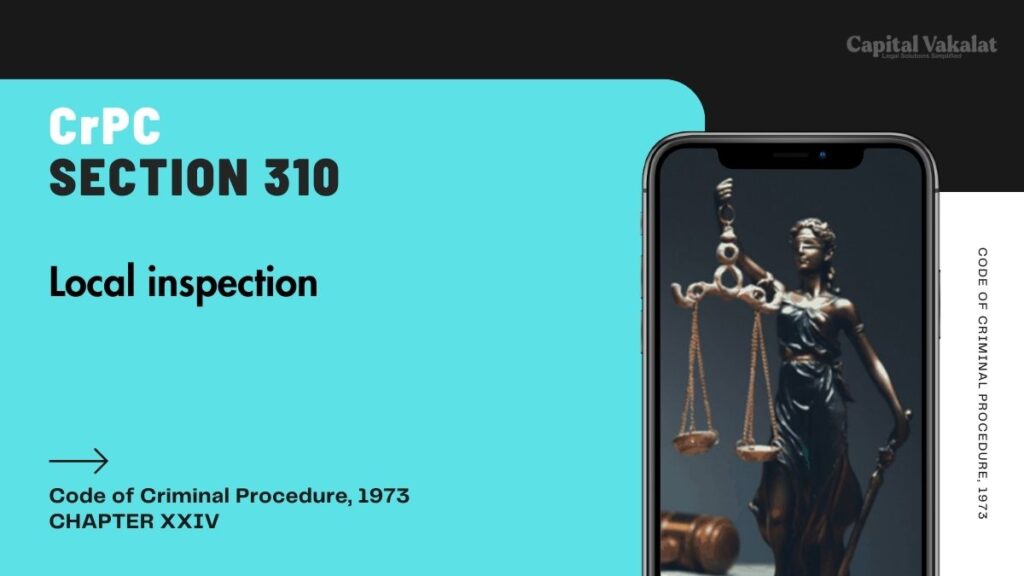The section 310 CrPC local inspection is a significant provision within the Code of Criminal Procedure (CrPC) in India, empowering judicial authorities to conduct on-site inspections to gather critical evidence. This article delves into the intricacies of this section, exploring its legal framework, procedural aspects, and implications for the judicial process.

Section 310 CrPC provides the legal basis for a judge or magistrate to conduct a local inspection of the scene relevant to a criminal case. This provision ensures that the court has the most accurate and direct evidence possible, aiding in the delivery of justice. It empowers the judicial authority to observe the actual conditions and gather firsthand information that may not be adequately represented through verbal testimony or documents.
Bare Act. Section 310 Cr.P.C.
Local inspection.
(1) Any Judge or Magistrate may, at any stage of any inquiry, trial or other proceeding, after due notice to the parties, visit and inspect any place in which an offence is alleged to have been committed, or any other place in which it is in his opinion necessary to view for the purpose of properly appreciating the evidence given at such inquiry or trial, and shall without unnecessary delay record a memorandum of any relevant facts observed at such inspection.
(2) Such memorandum shall form part of the record of the case and if the prosecutor, complainant or accused or any other party to the case, so desires, a copy of the memorandum shall be furnished to him free of cost.
Historical Context and Evolution
The origins of section 310 CrPC can be traced back to the need for more precise fact-finding in judicial processes. Over time, it has evolved to address various complexities in criminal investigations, ensuring that justice is not only done but seen to be done. This evolution underscores the importance of direct observation and evidence collection in delivering fair verdicts.
Legal Provisions and Framework
Section 310 CrPC falls under Chapter XXIV of the Code of Criminal Procedure, 1973. It states that any judge or magistrate presiding over a trial may, at any stage of the inquiry, trial, or other proceedings, visit and inspect any place in which an offense is alleged to have been committed or any other place which it is necessary to view for the purposes of properly appreciating the evidence given during the trial. This section is instrumental in bridging the gap between theoretical evidence and practical reality.
Procedure for Conducting Local Inspections
The procedure for conducting a local inspection under section 310 CrPC involves several steps:
- Decision to Inspect: The judge or magistrate must determine that a local inspection is necessary to understand the evidence better.
- Notification: Relevant parties, including the prosecution and defense, must be notified of the inspection.
- Conducting the Inspection: The judge or magistrate visits the site, observes the conditions, and may take notes or make sketches.
- Recording Observations: Observations made during the inspection are recorded and may be referenced during the trial.
- Reporting Findings: Any significant findings from the inspection are reported in court, contributing to the overall evidence.
Importance of Local Inspections in Criminal Justice
Local inspections are crucial in criminal justice for several reasons:
- Accuracy of Evidence: They ensure that the evidence presented in court is accurate and reflects the actual conditions of the scene.
- Visual Representation: They provide a visual representation of the scene, which can be more impactful than verbal descriptions.
- Clarification of Testimonies: They help clarify testimonies by providing a real-world context.
- Enhanced Understanding: They aid the judge or magistrate in understanding the spatial relationships and environmental factors that may influence the case.
Challenges and Limitations
While section 310 CrPC local inspection is valuable, it is not without challenges:
- Logistical Issues: Arranging for all relevant parties to be present at the inspection site can be challenging.
- Security Concerns: Ensuring the safety of the judicial authority and others during the inspection can be a concern, especially in volatile areas.
- Interpretative Bias: The observations made during the inspection can be subject to interpretative bias, potentially influencing the judge’s or magistrate’s perception of the evidence.
Case Studies and Precedents
Several landmark cases have demonstrated the application and significance of section 310 CrPC:
- Case A: In a high-profile murder trial, the local inspection revealed crucial details about the crime scene that were not apparent from the testimonies alone, leading to a breakthrough in the case.
- Case B: A fraud investigation benefited from a local inspection that uncovered hidden documents and discrepancies in the physical layout of the accused’s office.
Expert Opinions and Commentary
Legal experts and scholars often emphasize the importance of section 310 CrPC local inspection. According to Dr. R.K. Singh, a renowned legal scholar, “Local inspections under Section 310 CrPC play a pivotal role in ensuring that the judiciary has a comprehensive understanding of the facts, thereby facilitating a more informed and just decision-making process.”
Future Implications and Reforms
As the legal landscape evolves, the role of section 310 CrPC local inspection may expand. Potential reforms could include the integration of technology, such as drones or virtual reality, to enhance the accuracy and efficiency of local inspections. These advancements could mitigate some of the current logistical and security challenges, making local inspections more practical and less burdensome.
Conclusion
The provision for local inspections under section 310 CrPC is a cornerstone of the criminal justice system in India, ensuring that judicial authorities can base their decisions on the most accurate and direct evidence possible. Despite its challenges, the ability to conduct on-site inspections remains a powerful tool in the quest for justice, underscoring the importance of firsthand observation in legal proceedings.